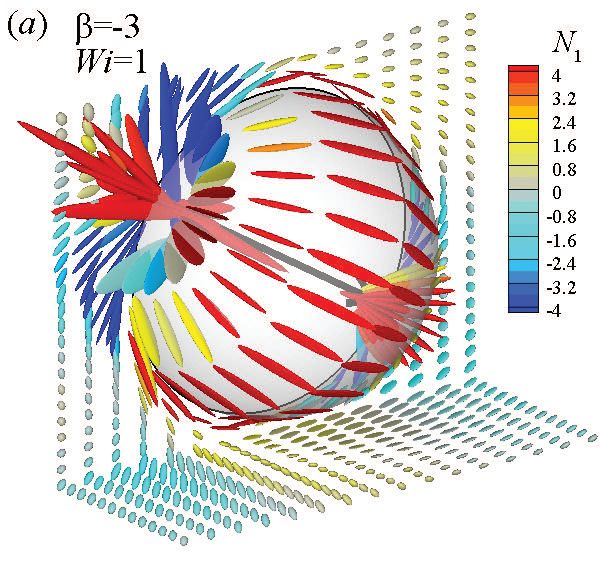Effect of solid surfaces on the swimming of microbes
Dr. Neil Canter, Contributing Editor | TLT Tech Beat December 2014
A three-dimensional mathematical model calculates the behavior of microbes swimming in a viscoelastic fluid near a solid wall.
KEY CONCEPTS
•
One factor to consider in how bacteria form biofilms is the presence of a viscoelastic environment near the microbes formed by their secretion of extracellular polymeric substances.
•
Microbe behavior was determined through the development of a three-dimensional mathematical model that calculated how microbes swim near a solid wall.
•
Bacteria function as pusher swimmers and remain in close proximity to the wall, providing further evidence for why they form biofilms on surfaces.
STRATEGIES TO MINIMIZE THE FORMATION OF BIOFILMS ARE A MAJOR FOCUS OF RESEARCH BECAUSE THEY ARE DIFFICULT TO REMOVE. Conventional treatments with biocides are ineffective because they cannot penetrate into the biofilm, which consists of a matrix of polymers and proteins that are generated by bacteria on surfaces.
Arezoo Ardekani, assistant professor of mechanical engineering at Purdue University in West Lafayette, Ind., says, “Biofilms can form everywhere including on catheters used to transfer body fluids, prosthetic valves and other devices.”
One other application where there are problems with bacteria and biofilms is water-based metalworking fluid systems. Bacteria will grow in these systems by literally eating the components of the metalworking fluid. This serves to reduce the ability of the metalworking fluid to provide lubricity, corrosion protection and emulsification.
Biofilms also can physically reduce fluid flow, plug filters and impede metal chip removal. As the bacterial levels continue to increase, the stress placed on the metalworking fluid eventually leads to premature failure.
A previous TLT article described research on how a specific bacterium,
Caulobacter crescents, attaches to a surface, leading to the eventual formation of a biofilm (
1). The bacterium goes through a two-stage process by first developing a low adherence to a specific surface that is reversible. If the bacterium decides to settle on the surface, it will secret a strong polysaccharide-based adhesive that can take place in about 10 seconds.
One other factor to consider is that the environment surrounding bacteria exhibits a viscoelasticity. Ardekani says, “Microbes impart viscoelasticity to the environment surrounding them through the secretion of extracellular polymeric substances that are dispersions of polysaccharides and proteins. This step provides extra protection for biofilms.”
Determining how microbes swim in a viscoelastic environment may provide further insight into how biofilm formation occurs and, more important, what steps can be done to stop it. Unfortunately, past studies did not take the close proximity of surfaces into account. Ardekani says, “Most past studies evaluating the swimming of microbes were conducted in limitless domains where no surfaces were present.”
To more effectively understand the behavior of microbes, research is needed to determine how they swim in a viscoelastic environment near a surface. Such a study has now been undertaken.
SQUIRMERS
Ardekani and her fellow researchers have used a three-dimensional mathematical model to evaluate the behavior of microbes swimming in a viscoelastic fluid near a solid wall. The model involves using inanimate objects known as squirmers. Ardekani says, “Squirmers are microswimmers that have a spherical cell body and move by generating a tangential surface motion.”
Simulations for the model were conducted in a rectangular domain that consisted of 60 x 40 x 40 cell radius. The researchers evaluated three types of squirmers in this study, which are known as pusher, puller and neutral swimmers.
“A pusher swimmer typically will propel itself through an aqueous medium by pushing fluid backwards. This is typically how most bacteria will swim by using flagella behind their bodies,” Ardekani says. “Most puller swimmers are algae that swim in a breast-stroke type fashion through the use of flagella in front of their body. Neutral swimmers are spherical microorganisms, such as Volvox, that neither push nor pull.”
The researchers examined how the swimming of the three types of squirmers is impacted by the elasticity of the fluid, shear thinning and the viscosity of the fluid. Ardekani says, “In a viscoelastic fluid, each polymer molecule in the solvent acts in a similar fashion to a spring. Fluid being sheared near the wall leads to the squirmer spending more time near the surface.”
The question that the researchers tried to answer is how the squirmers move near the wall. Do they stay close to the wall or do they escape?
The answer depends upon the type of swimmer. Ardekani says, “Pushers are most influenced by the viscoelasticity. They are trapped near the wall and cannot escape because of large stretching of polymer molecules behind the pusher inducing an elastic drag that prevents escaping motion.”
Puller swimmers are not as adversely influenced by the viscoelastic medium. Ardekani says, “Pullers are not affected at all by the environment near the wall and can readily escape.”
Neutral swimmers initially are found to be present near the wall. But Ardekani indicates that eventually over time they will escape. Figure 3 shows how the squirmers cause the polymers to stretch.
 Figure 3. Microorganisms swimming in a viscoelastic environment cause the stretching of polymers, leading to their attraction to surfaces and facilitating the formation of biofilms. (Courtesy of Purdue University)
Figure 3. Microorganisms swimming in a viscoelastic environment cause the stretching of polymers, leading to their attraction to surfaces and facilitating the formation of biofilms. (Courtesy of Purdue University)
This work provides insight into which types of swimmers remain in close proximity to a wall. Based on the behavior of bacteria to form biofilms on surfaces, the researchers have confirmed the tendency of bacteria as pusher swimmers to remain near the surface.
Future work will involve trying to more accurately depict the behavior of microbes. Ardekani says, “Our intention is to look at mathematical models that are closer to bacteria where we do not use the spherical shapes of squirmers, but, rather, attach flagella to the back of ellipsoidal cell bodies to more accurately evaluate their swimming motion.”
Additional information can be found in a recent article (
2) or by contacting Ardekani at
ardekani@purdue.edu.
REFERENCES
1.
Canter, N. (2012), “Bacterial adhesion on surfaces,” TLT,
68 (3), pp. 12-13.
2.
Li, G., Karimi, A. and Ardekani, A. (2014), “Effect of solid boundaries on swimming dynamics of microorganisms in a viscoelastic fluid,”
Rheologica Acta, DOI: 10.1007/s00397-014-0796-9.
 Neil Canter heads his own consulting company, Chemical Solutions, in Willow Grove, Pa. Ideas for Tech Beat items can be sent to him at neilcanter@comcast.net
Neil Canter heads his own consulting company, Chemical Solutions, in Willow Grove, Pa. Ideas for Tech Beat items can be sent to him at neilcanter@comcast.net.